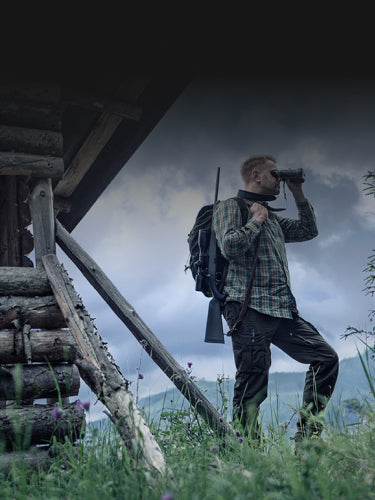A thermal riflescope is built for shooting, not for searching. Walking through the woods at night with your rifle shouldered, peering down the scope at every sound, is as impractical as it is unsafe. You wear yourself out, point a loaded gun at things you never intend to shoot, and still only see a narrow slice of the world in front of you.
That’s where a thermal monocular earns its place. It lets you scan wide areas quickly, keep your rifle slung until you need it, and approach every encounter with both awareness and control.
Why Use a Thermal Monocular with a Riflescope?
A monocular like the Pulsar Oryx LRF XG35 makes long hours in the field more efficient. Instead of holding your rifle up to scan, you can cover wide ground quickly and with less fatigue. Once you’ve identified a target, you transition to the riflescope for the shot.
This division of labor is why serious hog and predator hunters often carry both. The monocular handles detection. The scope handles engagement.
The Role of Consistent Settings
Problems arise when each device is configured differently. Spotting an animal in white hot on your monocular, then switching to a scope set on red hot, slows you down. At best, you hesitate. At worst, you mistake what you’re seeing.
Keep your devices aligned:
-
Color Palette – Match white hot, black hot, or color across both.
-
Brightness/Contrast – Adjust so heat signatures appear at similar levels.
-
Magnification – Use the monocular at low zoom to find movement. Leave detailed observation to the scope.
These small adjustments ensure that the transition from one device to the other is immediate and natural.
Pulsar Oryx LRF XG35 and Thermion 2 LRF XL60: A Paired System
Pulsar builds devices with this kind of paired use in mind.
-
Oryx LRF XG35: Compact thermal monocular with long detection range and an integrated rangefinder. Ideal for scanning large fields or thick cover.
-
Thermion 2 LRF XL60: Thermal riflescope designed in the form of a traditional optic. Delivers high-resolution thermal imaging, onboard rangefinding, and rugged durability.
Together, they cover both sides of the hunt: detection and precision.
Practical Advantages
Running both devices with consistent settings provides:
-
Faster target acquisition.
-
Less physical strain during long hunts.
-
Clearer target identification.
-
More reliable shot placement.
Final Thoughts
Thermal night vision works best when devices complement one another. A monocular for scanning and a riflescope for shooting is the most practical system for night hunting. Keep their settings consistent, and the transition from one to the other becomes second nature.
With the Oryx and Thermion 2, Pulsar offers hunters the tools to build that system and use thermal night vision to its fullest.
Frequently Asked Questions
Why pair a thermal monocular with a thermal riflescope?
A monocular lets you scan wide areas without shouldering your rifle, reducing fatigue and improving safety. Once you detect and identify a target, you move to the riflescope to take a precise shot.
Is it a bad idea to scan using only a riflescope?
Yes. Scanning through a riflescope is slow, tiring, and unsafe because it points a loaded firearm at everything you look at. A handheld monocular keeps the rifle slung until it is time to shoot.
What settings should match between my monocular and scope?
Align color palette, brightness and contrast so heat signatures look similar on both devices. Use low magnification on the monocular for detection and rely on the riflescope for detailed observation and engagement.
Which Pulsar models work well together?
The Oryx LRF XG35 thermal monocular pairs naturally with a Thermion 2 LRF thermal riflescope such as the XL60. The monocular handles detection and ranging, while the scope provides high-resolution aiming with onboard rangefinding.
Do I need a laser rangefinder on both devices?
It is not required, but having ranging on the monocular and the riflescope adds flexibility. You can confirm distance during detection and again at the shot for better holdovers and more confident hits.





1 comment
Looking for at maybe the proton to attach to my leupold rifle scope.